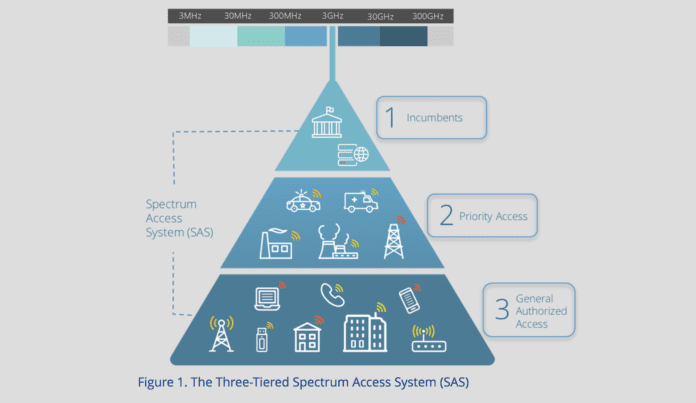As the Citizens Broadband Radio Service shared spectrum stands on the brink of readiness for early deployments, AT&T has asked federal regulators to reconsider the rules around power transmission for CBRS base stations, and add a new, higher-power category of base station that would help support 5G New Radio.
According to a filing with the Federal Communications Commission, AT&T noted that the allowable Effective Isotropic Radiated Power (EIRP) for base stations in licensed 2 GHz frequencies is in the range of about 60 dBm, while it is about 53 dBm for 40 megahertz of CBRS spectrum. The difference in transmission power reduces CBRS signal propagation by about 2 miles compared to a licensed 2 GHz site, AT&T claimed.
“Higher power allows operational [and] technical flexibility and enables additional use 5G cases for CBRS as a mid-band anchor for NR,” AT&T said in its filing. It is asking the FCC to allow a new class of Citizens Broadband Radio Devices (CBSDs) that would be allowed to transmit at an EIRP up to 62 dBm/10 MHz, compared to current limits of 30 dBm/10 MHz for Category A access points (which are designed primarily for indoor use) and 47 dBm/10 MHz for Category B access points, which may only be installed outdoors.
The carrier said that its proposal to add a new class of CBRS base stations would continue to protect incumbent users under the current Part 96 rules, and would not impact current Spectrum Access System certifications or the fairness of sharing under already-established protections and rules. Nevertheless, the proposal immediately was met with protests by a coalition of other companies interested in the CBRS band, including Altice USA, Frontier Communications, the Wireless Internet Service Providers Association, Motorola Solutions, Windstream, the American Petroleum Institute and NCTA – The Internet & Television Association.
In a letter to the FCC, the coalition wrote to express “in the strongest of terms” their objections to the proposal and urge the FCC to meet AT&T’s request “with a resounding ‘NO.'”
The higher-power transmissions would “wreak havoc on CBRS,” the coalition wrote.
“First, increasing power would result in larger Priority Access License Protection Areas and foreclose opportunistic GAA for a variety of uses cases other than the traditional cellular deployments that AT&T envisions,” the letter said. “That result would be contrary to the balanced policies the Commission adopted in 2015 and re-confirmed in 2016 and 2017. Second, operation at higher power levels near the coastlines and near inland military facilities would be heavily constrained by the need to protect the Environmental Sensing Capabilities, which ensure protection of fixed and shipborne military users. Higher power would also have a greater impact on Dynamic Protection Areas, and significantly increase the distance from the coastline where DPA activation can impact service. Detailed NTIA and DoD study and analysis would be needed to assess the much greater interference impact of higher powered CBSDs in the band.”
The coalition went on to say that “higher power levels would also create additional interference issues for both base station and user equipment. The current regulations limit out of channel signal levels to low levels, because there are no guard bands in CBRS, and creating them would further foreclose GAA and PAL operation. Higher power levels with the same out of channel levels would be more difficult to achieve. Even if out of channel signals could be controlled, the higher power levels could potentially cause more interference to user equipment operating on adjacent channels. The current balance of PAL and GAA operation depends upon not requiring guard bands. A 15 dB increase in signal power, however, would upset that balance. This would leave very little room for GAA operations, and potentially none in areas where satellite incumbents operate below 3700 MHz.”
According to AT&T’s own presentation and information also cited by the opposing coalition, the FCC already raised the power transmit limits for outdoor CBRS base stations previously, acknowledging that doing so would reduce deployment costs because fewer sites could be used to cover an area — but not raising them further than the current rules, because the agency wanted to balance transit power’s impact on coexistence as well as spatial re-use of the band and overall capacity. T-Mobile US had also repeatedly requested that the FCC to raise the transmit power levels, according to the coalition’s letter.
The formal certification of the SASes is the final piece that must fall into place before CBRS deployments can officially begin. The FCC does not expect an auction of Priority Access Licenses until next year, but with the recent approvals of the required coastal sensor Environmental Sensing Capability networks, initial commercial deployments (ICD) under General Authorized Access to the spectrum can start once the SASes receive final approvals — so this is a very last-minute request by AT&T, which the coalition noted.
“At this stage, on the verge of ICD and commercial GAA use, AT&T’s proposal could be even more disruptive than T-Mobile’s,” according to the letter. “The Commission has established a ‘workable framework’ for all stakeholders – incumbents, rural broadband providers, neutral host networks, private broadband networks, the Internet of Things and a host of other use cases. It should be noted that several of these use cases involve 5G air interface technologies. AT&T’s proposal would severely undermine these uses, destroy investment, limit innovation and convert the CBRS band into something more closely resembling the ‘command and control’ regulatory model the Commission has many times rejected.”

